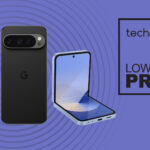Why you can trust TechRadar
We spend hours testing every product or service we review, so you can be sure you’re buying the best. Find out more about how we test.
Xreal One: One-Minute Review
I’ve tested my fair share of AR smart glasses in the past few years, and the Xreal One glasses might be the best smart glasses I’ve tried.
Xreal’s expertise shines through with these specs, which not only boast an impressive full-HD 120Hz OLED image with vivid colors, impressive contrast, and a 600-nit brightness, but also solid audio courtesy of Bose.
Headphones will still deliver better audio, but these smart glasses don’t feel incomplete without a pair of cans – something I can’t say of their rivals.
Though if you’re picking up the Xreal One you’ll probably also want to grab Xreal’s Beam Pro – a smartphone-like companion device that adds features like easy spatial photo capture without an iPhone 15 Pro, and two USB-C ports.
The Beam Pro starts at $199 / £189 for a model with 128GB of storage and 6GB of RAM, and while it’s not technically required it compliments the Xreal One so well that it feels like you’re missing out without it.
You can also connect the glasses to a suite of compatible USB-C devices instead like most smartphones, laptops, and game consoles (though for the latter you might need an add-on HDMI adapter). It’s perfect for watching your favorite show or playing a game on a giant virtual display, or for working privately on sensitive work documents in the office, or while you’re traveling, as only you can see your screen.
At $499 / £449 the Xreal One are approaching the pricier end of the scale, but with solid specs these glasses justify their cos, and are worth picking up if you want premium performance.
Xreal One: Price and availability
The Xreal One is available to buy in the UK and US from Xreal.com for $499 / £449.
This puts it at the mid-range price for AR glasses – it’s more expensive than older and more budget-friendly options like the Xreal Air 2 and RayNeo Air 3S, but less expensive than high-end standalone AR glasses like the Xreal Air 2 Ultra, and the upgraded (and soon to release) Xreal One Pro.
Xreal One: Design
- Wired USB-C connection
- 82g, comfy for long stretches
- Electrochromic dimming shades
The Xreal One doesn’t reinvent the wheel when it comes to Xreal’s AR glasses design. That is, at a glance it looks like a pair of sunglasses – albeit with a thick frame and large displays situated behind the lenses.
Just as on other wired AR specs the USB-C cable feeds into a port at the end of the left arm, and can be connected to a suite of USB-C devices that support DisplayPort – or to other devices with the right cables and accessories like an HDMI-to-USB-C cable.
Meanwhile the right arm features all of the buttons. On the bottom of the arm you’ll find a Red button which when pressed switches between Anchor mode and Follow mode (which anchors the screen in space or has it follow you as you move your head), and a brightness bar – you make the screen brighter, or change the electrochromic dimming intensity between three levels.
On top you’ll find a small black ‘Quick button’ for toggling between your display and dimming settings and transparency mode – which takes away your screen and resets the lenses to clear, so you can see what’s going on around you.
There are no volume controls on the specs, so you’ll need to rely on your device’s audio controls.
During my tests I only really used them on max brightness with the dimming turned up to full, as this created the best viewing conditions, though the transparency mode toggle came in handy a few times, and when using the Xreal Ones in a dark environment it was handy to turn the brightness down a tad so there wasn’t as much glare.
To find the best fit for you there are three arm angles so you can tilt the screen, and three nose pad options, so you can have the glasses sit correctly on your face. In my testing, after adjusting the specs I was able to comfortably wear the glasses, which weigh just 84g, for hours at a time with no trouble.
The Xreal One glasses also come with a cleaning cloth and a hard carry case so you can keep them clean and easily transport them and their cable.
Xreal One: Performance
- Impressive Bose audio
- Full-HD, 120Hz image at 600-nit brightness
- Pairs with a plethora of USB-C devices
Instead of beginning with the visual quality of the Xreal One (which is great by the way – more on that in a moment) I want to start this section by praising their audio. Normally, smart glasses audio is bordering on bad – the small open-air speakers produce a hollow sound that’s passable for watching films, but a pair of headphones often feel like a necessity rather than an optional add-on. Thanks to Bose engineered sound that’s not the case with the Xreal One specs – the audio performance is one of their best features.
They’re not perfect for music, but compared to the Xreal Air 2 there’s a stark improvement. This makes the immersive movie and TV show watching experience significantly better without requiring any headphones, meaning the specs feel like a more complete package out of the box. What’s more they seem to be less leaky than on previous models – audio can still be heard by people sitting close by, but it’s a lot better.
Now for the visuals. The Xreal One specs boast a 1080p image produced by Sony Micro-OLED displays that boast a peak 600nits perceived brightness, a 120Hz refresh rate, and a 50-degree field of view.
The end result is an image that looks really good. Yes it’s only Full HD quality but the colors are beautiful, and the excellent contrast is super-handy when you’re trying to follow the action in dark scenes (though you’ll need the brightness set to max).
I’ve been using the smart specs to stream Daredevil: Born Again (it’s superb by the way), Invincible season 3 (also great), and play games using my PC and PS5 by connecting them to the specs via HDMI adapters.
The high refresh rate and low lag help to ensure that games look smooth, and it was a blast to watch the action unfold on a giant 147-inch virtual screen.
While using them with my PC I also gave the specs a whirl for working. Having your documents laid out on a larger monitor was certainly handy, but one big advantage I found was these specs are excellent for working privately, especially while traveling. I could be writing up an embargoed story on a train or flight, and because only I can see my virtual laptop screen I don’t have to worry about people looking over my shoulder and seeing any information they aren’t meant to.
I just wish the Nebula app for Mac wasn’t still in beta, and that the also in-beta Windows app was easier to find (I had to go through Reddit rather than Xreal’s own website).
While you can use the Xreal One glasses with a plethora of USB-C devices, by far your best bet is the Xreal Beam Pro. It’s a smartphone-like add-on that’s built by Xreal to be the perfect companion to its glasses, and the company has thoroughly succeeded in that regard. If your budget can stretch to purchasing the Xreal One and a Beam pro in a bundle, do it.
Should you buy the Xreal One glasses?
|
Attribute |
Comment |
Score |
|---|---|---|
|
Value |
The Xreal One glasses are pricey but they deliver a strong performance. I would like a little more for the price, but compared to their equally expensive rivals they’re a cut above. |
3.5/5 |
|
Design |
The Xreal One design sticks to a tried and true formula. They do nothing special, but they’re effective and comfy to wear. |
5/5 |
|
Performance |
The image and sound performance of these glasses is great, but you’ll want an Xreal Beam Pro to get the most out of them. |
4.5/5 |
Buy it if…
Don’t buy it if…
Also consider
How I tested the Xreal One glasses
I spent a few weeks testing the Xreal One specs for different use cases – gaming, entertainment, and productivity. I mostly used them at home on my couch, in bed, or at my desk, but I also made sure to take them with me on a couple of flights I took, and also used them during my commute a few times to get a sense of their capabilities in different environments.
I hooked them up to my PC, PS5 and smartphone (a Samsung Galaxy Z Fold 6), but my main connected device of choice was the Xreal Beam Pro. It’s the ideal companion for Xreal’s AR smart glasses, and worth picking up if you’re buying the Xreal One.
Read more about how we test.
- First reviewed March 2025
Read the full article here













